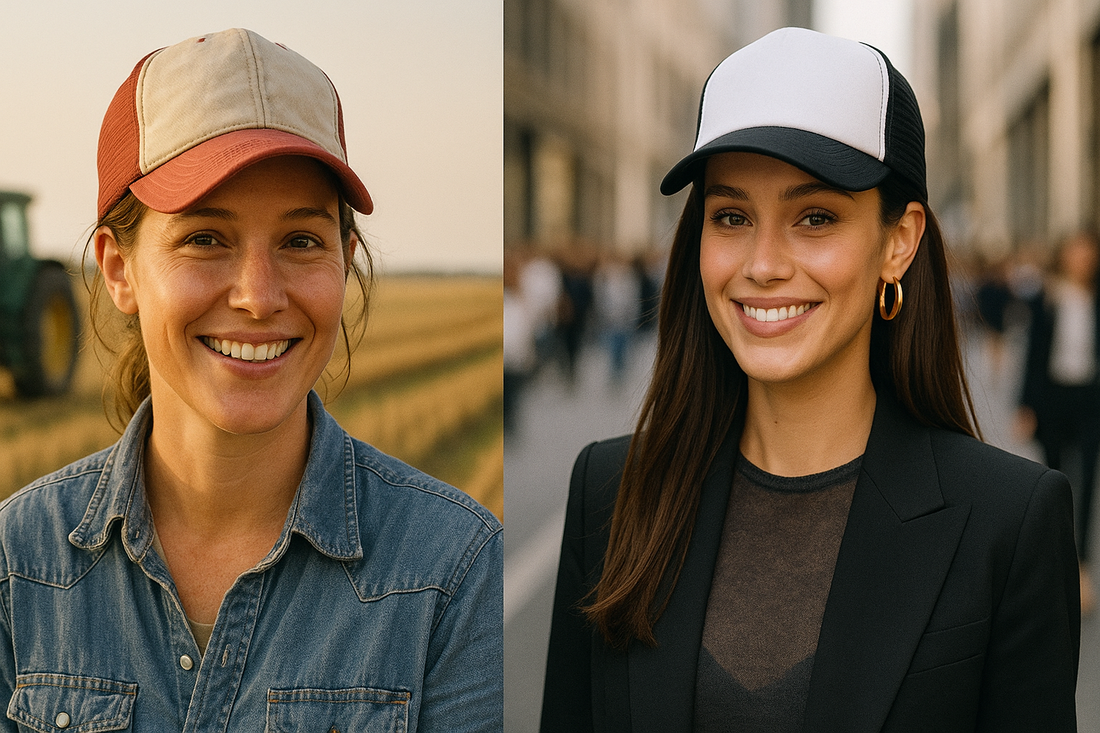
From Farmland to Fashion Week: The Wild Ride of the Trucker Hat
Share
Once a freebie from feed stores—now a $200 accessory on the runway. How did the trucker hat go from forgotten to iconic?
For decades, it sat quietly on dashboards and heads across America's backroads. Unassuming. Functional. Free. But then something strange happened: the trucker hat, born in utility and steeped in rural grit, suddenly appeared on the scalps of celebrities and the catwalks of Paris.
This is the improbable journey of one of fashion’s most paradoxical symbols: the trucker hat.
Humble Beginnings: The Birth of a Blue-Collar Billboard
1970s: Utility Meets Advertising
The trucker hat emerged in the 1970s, not from a designer’s sketchpad, but from the marketing departments of agricultural supply companies. Feed and farming brands like John Deere, Caterpillar, and Mossy Oak began giving away mesh-backed hats with foam fronts as promotional merchandise.
They were cheap to make, breathable in the summer, and boasted a wide front panel—perfect for slapping a logo on.
And truckers? They were the ideal walking billboards, traveling cross-country with these branded hats perched proudly above the wheel.
1990s: Still Working-Class, Still Overlooked
Throughout the 1980s and 1990s, the trucker hat remained firmly in the functional fashion category. Worn by farmers, mechanics, truck drivers, and rural laborers, it was never intended as a statement.
In urban fashion circles, it was virtually invisible. To the style elite, the trucker hat was unfashionable by design—a hat for people who worked outside, not inside boutiques.
But just as with flannel shirts and work boots, irony has a way of resurrecting the forgotten.
2000s: The Ironic Revival
Von Dutch, Ashton Kutcher, and the Celebrity Co-Sign
In the early 2000s, a curious twist of fate—and Hollywood irony—launched the trucker hat into the realm of fashion cult status.
Enter Von Dutch, a brand that combined rockabilly edge with streetwear swagger. Fueled by celebrities like Ashton Kutcher, Britney Spears, and Pharrell Williams, Von Dutch trucker hats became the must-have accessory of the early Y2K era.
What was once a symbol of rural anonymity was now selling for $100 or more, snapped up by people who had never set foot on a farm.
Critics called it “blue-collar cosplay.” Fans called it fashion-forward. Either way, the trucker hat was no longer ignored.
2010s–2020s: From Ironic to Iconic
As the 2000s ended, trucker hats cooled off—briefly. But fashion, like history, repeats itself.
In the 2010s and early 2020s, streetwear brands like Supreme, Balenciaga, and Off-White began reinterpreting the trucker hat again—this time with post-ironic sincerity. Meanwhile, vintage and thrift culture gave new life to older hats, especially those with retro logos and authentic wear.
Suddenly, authenticity became currency. A dirt-stained Co-op hat from 1983? Worth more than a brand-new snapback at Supreme.
The Psychology of the Trucker Hat: Irony, Identity, and Americana
Why does the trucker hat keep returning? It speaks to something uniquely American: rebellion wrapped in utility. It’s a working-class relic co-opted by artists, rappers, and designers to signal nonconformity, even if the wearer is far from a cornfield.
It’s equal parts nostalgia, anti-fashion, and cultural appropriation—depending on who's wearing it and why.
More Than Just Mesh and Foam
The trucker hat’s journey from rural marketing freebie to runway accessory is one of fashion’s most unexpected evolutions. It represents a collision between worlds: country and city, earnestness and irony, function and fashion.
And like all iconic garments, it refuses to stay in one lane.